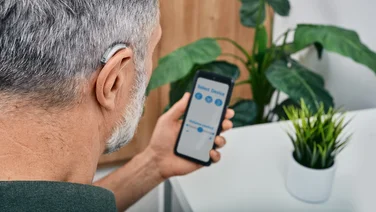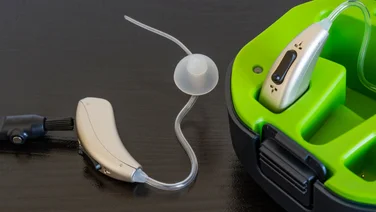To help us provide you with free impartial advice, we may earn a commission if you buy through links on our site. Learn more

If Specsavers’ affordable hearing aids get more popular, they might want to think about changing their name – they sold half a million aids in 2022, receiving “good” or “excellent” feedback from 93% of their customers. That’s seriously impressive, so why are we devoting a whole page to Specsavers hearing aid problems?
Specsavers sells a wide range of hearing aids that cover most current types, sizes and brands, including Phonak, Signia and Philips – even their own-brand hearing aids are made by Phonak and Signia – so any problems people might encounter with Specsavers’ hearing aids are essentially the same problems you’d encounter with hearing aids from other retailers.
Below we’ll run through the most common problems, explain possible reasons for them, and offer some tips on how to fix them at home. We’ll also look at Specsavers’ hearing aid customer aftercare, but most of our advice will be relevant no matter where you bought your hearing aids.
Get a free quote for hearing aids today
Take our quick survey and we’ll connect you with a local specialist based on your requirements.
READ NEXT: Specsavers hearing aid pricesWhat are the most common Specsavers hearing aid problems?
The most common problems tend to apply to all hearing aid types, including behind-the-ear (BTE), in-the-ear (ITE), in-the-canal (ITC), and the smallest, invisible-in-canal hearing aids (IIC), all of which are available from Specsavers. These are the main issues you may face:
Distorted sound. Uncomfortable, tinny, or choppy sound is not inevitable for hearing aid users. The most common causes for this distortion are damaged battery contacts, a corroded battery, or a hearing aid that simply needs cleaning.
No sound, or not enough amplification. This is often caused by either a low battery or moisture in the tubing.
Whistling and feedback. The high-pitched whistle that occasionally blights the lives of hearing aid users – and delights fans of the Jesus and Mary Chain – is feedback, which is the sound bouncing off of the vents of your hearing aid and back into the microphone, causing the sound to be re-amplified in a loop. This usually happens when the volume is set too high, the ear canal is blocked by wax, or when the hearing aid isn’t properly sealed in the ear.
Uncomfortable fit. It’s normal for a hearing aid to feel unusual at first, but if you don’t acclimate to it, you may need to get it refitted.
The hearing aid stops working. An apparently dead hearing aid can sometimes be caused by a faulty battery, settings that have been accidentally changed, or a tube that’s been blocked by water, earwax, debris, or just by a twist in the tube. If you check all of these and the hearing aid really has stopped working, it’ll need to go back to Specsavers.
Looking for a quote for hearing aids?
Which hearing aids have the most problems?
No one type of hearing aid is particularly prone to problems over the others, but different types face their own issues.
Hearing aid batteries can cause problems for users of non-rechargeable hearing aids, such as the Specsavers Advance Star. As with all single-use batteries, hearing aid batteries can sometimes corrode, or even leak, and this may damage the battery compartment or the contacts, causing sound distortion and occasionally stopping the hearing aid from working at all. Batteries can also get stuck in the battery compartment.
Rechargeable hearing aids, such as the Signia AX, may lose charge faster than expected, or stop charging altogether. But other potential problems can include lost or malfunctioning chargers.
Bluetooth hearing aids are increasingly the standard, but the Bluetooth functions in hearing aids, such as the Specsavers Advance 80, can be tricky for some users to set up, and it may not always pair, connect, or disconnect when you want it to.
Instant fit hearing aids, such as the Signia Active Pro, are convenient because you don’t have to be moulded to get a hearing aid that fits your ear canal. The downside is that they don’t fit perfectly, which can make them prone to feedback and falling out.READ NEXT: Get connected with Bluetooth hearing aids
How can I fix my hearing aid at home?
You can usually get your hearing aid working well again without having to contact Specsavers, let alone going to a store. Here are a few “first-aid” fixes to try at home:
Distorted sound, no sound, or too quiet: If your hearing aid takes a disposable battery, that should be the first thing to check. Replace it with a new battery, especially if it looks corroded, and clean the small metal prongs that contact with the battery when you close the device door. If the battery is new or fully charged, check that the battery door is closed properly and that the battery hasn’t been put in upside-down.
Check your hearing aid’s settings, which may have been switched to wireless by accident. Try adjusting your hearing aid’s volume through your remote control, or smartphone app, and try switching to a different noise reduction preset if available.
It’s also worth checking for earwax in the microphones or the sound outlet, and gently cleaning away any blockage. If that doesn’t help, replace the wax guard filter on the end of the speaker wire. Unfortunately, Specsavers doesn’t sell these online, but Amazon has filter kits for Specsavers’ brands, such as Signia Quickguards (£5.43 for eight). Also check the plastic tubing, as this may have become kinked or be in need of cleaning. For help on this, see our in-depth guide to cleaning hearing aids properly at home.
If your amplification appears to have deteriorated gradually over time, it may actually be down to a change in your level of hearing loss. Your best bet here is to have your hearing aid settings re-adjusted by your audiologist.
Whistling or feedback: Remove your hearing aids and put them back in to seal the fit, and turn down the volume. If your hearing aid is whistling, check that the dome or mould is inserted correctly in your ear canal, and be aware that it may indicate that your hearing aid doesn’t fit properly and needs a new custom mould.
Regular feedback problems may be a sign of earwax build-up, which you can get fixed at Specsavers with an earwax removal appointment.
Uncomfortable fit: This is tricky to fix at home if the problem persists. You’re unlikely to need a new hearing aid, but you may need a new custom mould.
Battery is stuck: Don’t attack your hearing aid or its battery with a screwdriver! Instead, take it to a Specsavers store and they will use a special extractor to free the battery for you.
Bluetooth won’t connect: Turning your hearing aids off and on again may actually help here. If that doesn’t work, ‘forget’ the devices in the Bluetooth list on your phone and in your hearing aid app, then restart the phone and re-pair your hearing aids. It might also be worth checking that your phone is updated to the latest operating system.
Hearing aid won’t charge: The most likely cause is dust or debris on the contacts of your charging case, so unplug it and give it a clean. Phonak also suggests charging the charger for three hours without hearing aids in it. If these steps don’t work, head to Specsavers to get the hearing aid and the charger checked out.
If you’ve lost the charger, and can’t get a replacement from Specsavers, Amazon has a good range of chargers from Phonak, Oticon and Starkey.
Hearing aid becomes wet: Turn it off, remove the batteries, and don’t press any buttons. Dry out your hearing aid in front of a fan, or use a cool, gentle hair dryer. Contrary to popular opinion, don’t put it in rice – that doesn’t work and is likely to get debris in your hearing aid. Once you’re certain it is completely dry, try charging it or replacing the battery.
The Help at Home section of Specsavers’ website offers many of these basic suggestions – changing the battery, checking the door is closed, and, of course, switching your aid off and on again – but if you can’t revive it and you’re within Specsavers’ four-year warranty period, take it to a branch to be repaired for free.
Looking for a quote for hearing aids?
How can I get help for my Specsavers hearing aids?
Specsavers offers an excellent level of aftercare with its hearing aids, as we mentioned in our article on Specsavers hearing aid prices. All of their pricing packages and hearing aids come with:
- Free advice
- Remote assistance
- Remote fine-tuning
- Four years’ supply of batteries
Customers get free adjustments and advice in any Specsavers “hearing store”, which is a branch with an audiologist. Find the one closest to you using Specsavers’ interactive online map.
Specsavers’ remote assistance is also free for their customers, and particularly useful for anyone who struggles with mobility issues or lives far from a store. This service lets you book an appointment with a hearing specialist either as a phone call or online video chat, whichever you prefer.

You can even ask the audiologist to adjust your hearing aid settings via your mobile phone. This remote fine-tuning service is included in the free remote assistance aftercare package, and is a much quicker and more convenient way to have your hearing aid adjusted than by travelling to a store.
For instant advice on adjusting and fixing your hearing aid, use the online chat function on the Aftercare. You can also ask for a copy of your hearing test data via the chat tool.READ NEXT: How to clean your hearing aid at home
Is there a money-back guarantee on Specsavers hearing aids?
All Specsavers hearing aids come with a 100-day money-back guarantee, although the aids should be “in the same condition to how they were sold with all packaging and accessories intact”.
Specsavers also includes a four-year repair warranty on hearing aids and wireless accessories, such as TV streamers. This warranty covers your aids and accessories against malfunction, breakdown and faulty workmanship.






